Family : Synanceiidae

Text © Giuseppe Mazza

English translation by Mario Beltramini
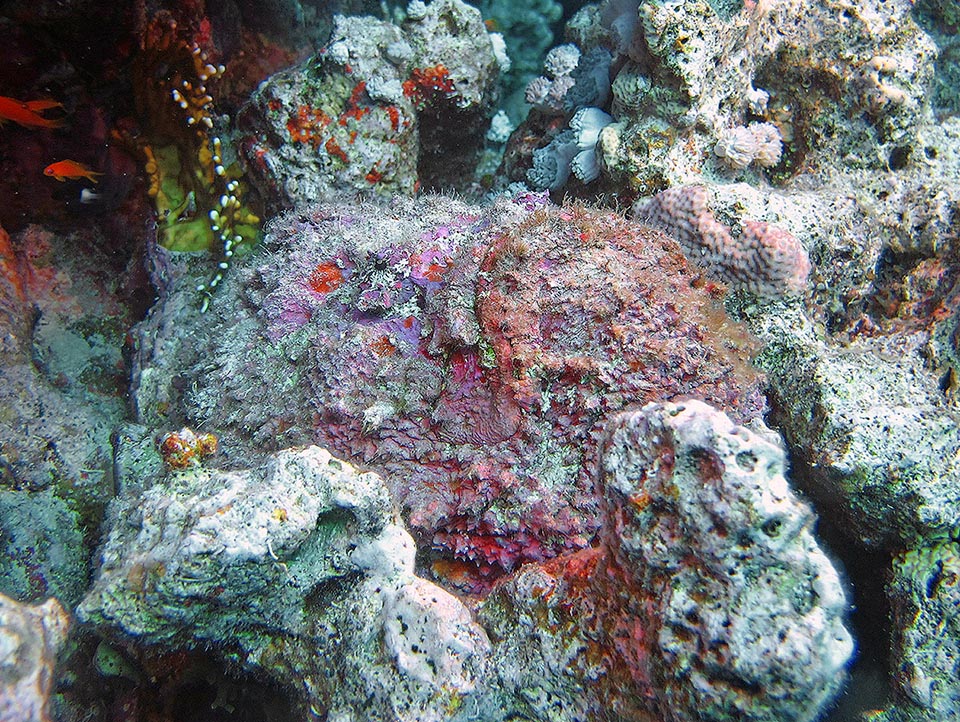
Apart from the eye, it is not easy to glimpse in this shapeless mass the presence of a Stonefish (Synanceia verrucosa) the world most poisonous © Ettore Balocchi
The Stonefish (Synanceia verrucosa Bloch & Schneider, 1801) belongs to the class of Actinopterygii, the ray-finned fishes, to the Scorpaeniformes, the order of the scorpionfishes, and to the family of Synanceiidae that nowadays counts, after the last taxonomic revisions, 9 genera and 40 species.
The etymology of the genus Synanceia comes from “syn-”, with, and “aggeon”. pot, with reference to the fleshy outgrowths 12 to 14 venomous spines on the dorsal fin.
The name of the species verrucosa evokes in Latin the presence of warts.
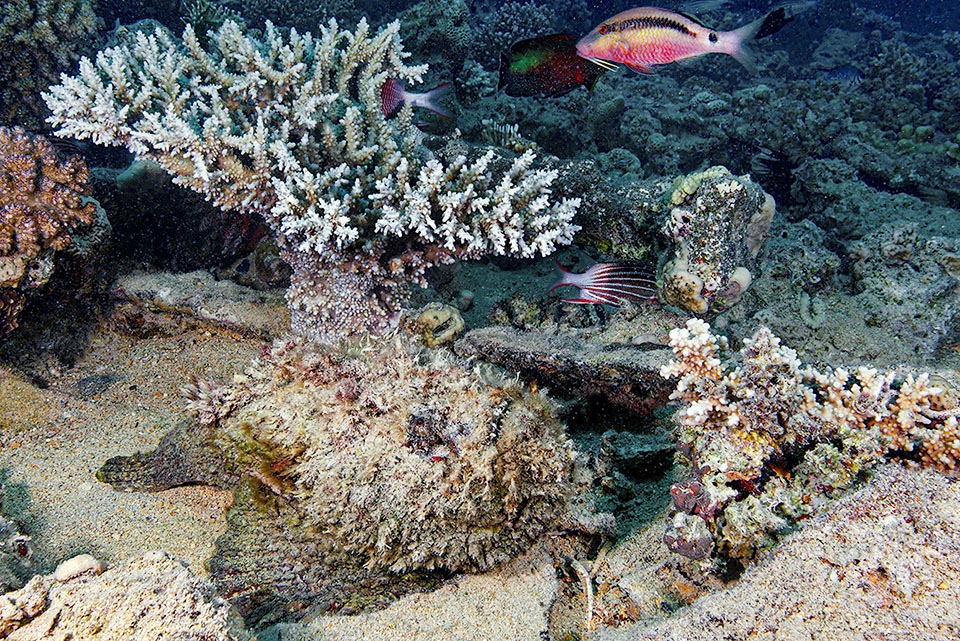
Always adapts colour and posture to environment. Here, mimicked at the base of the madrepore, waits for fishes to get close for gulping them in 15 thousandths of a second © Jim Greenfield
Zoogeography
Synanceia verrucosa has very vast distribution in the tropical waters of the Indian and Pacific oceans.
We find it, indicatively, from South Africa and Madagascar up to the Red Sea and the Arabic Sea, the Seychelles, Mauritius, Réunion and Maldives, in India, Sri Lanka, Thailand, the Andaman Islands, Cocos, Christmas Island, in Australia, Indonesia, Micronesia, New Guinea, Philippines, Taiwan and China, up to the Ryukyu and Ogasawara Islands in southern Japan.
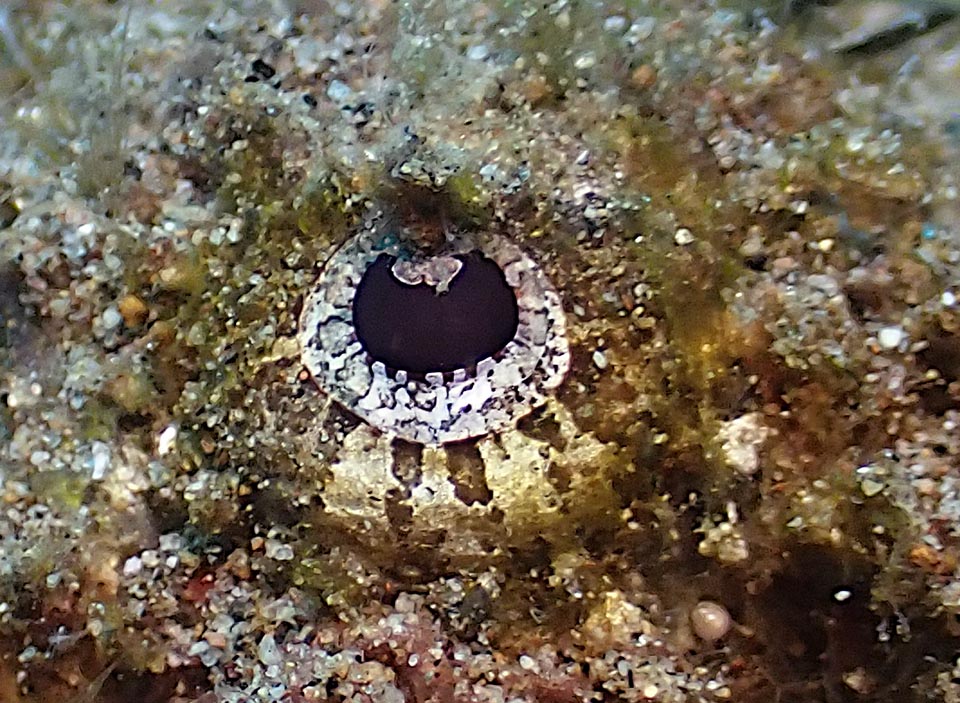
The skin secretes a sticky mucus that seizes, increasing the mimicry, fragments of corals and weeds, and the vigilant eye surveys also the movements of the crustaceans © Klaus Stiefel
Eastward, it has colonized Samoa, Niue, Tonga and French Polynesia with Tahiti. Southward, in the Pacific, Vanuatu, New Caledonia, Cook Island and Queensland.
Ecology-Habitat
Synanceia verrucosa lives in shallow waters, camouflaged among rocks and corals, up to 30 m of depth. It does not disdain debris and sandy substrata of the lagoons, where often partly inters, and during the low water it can be found, covered by mimetic weeds, in the rock pools.
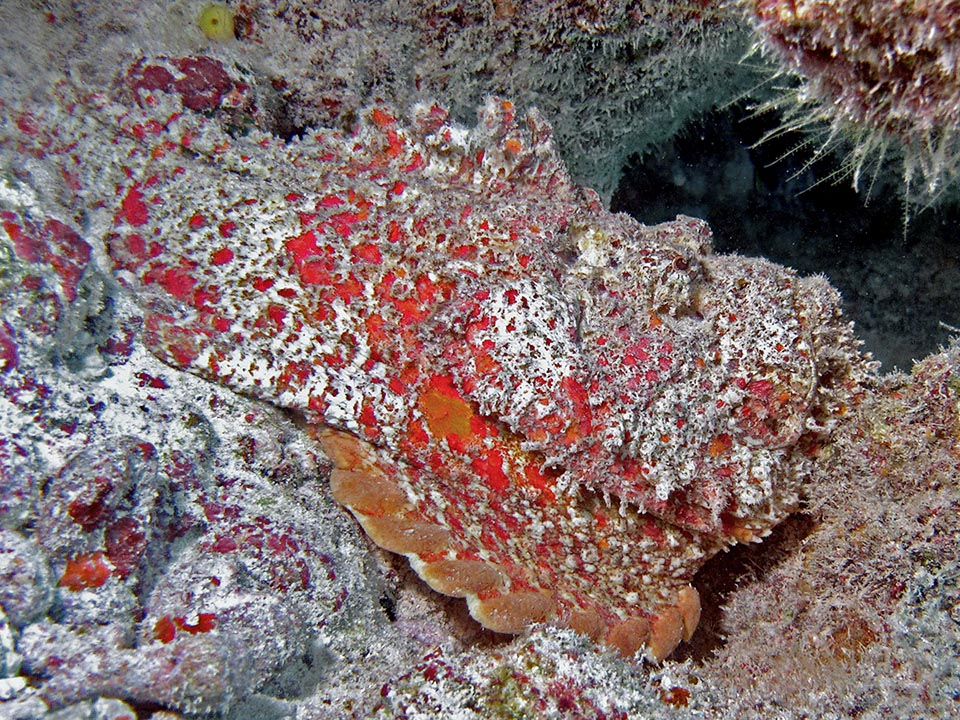
It lives in the tropical Indo-Pacific up to 30 m of depth, but is usually found in shallower waters, also covered by weeds in the cliff pools © Ettore Balocchi
Morpho-physiology
It can reach the 40 cm and the weight of 2,4 kg. The body, fusiform towards the tail, is stocky and squat, with the bare skin, studded with warts and protuberances of all sorts.
The colours are changeable and very different depending on the habitat.
There is black, grey, green, magenta, red, orange, pink and yellow.
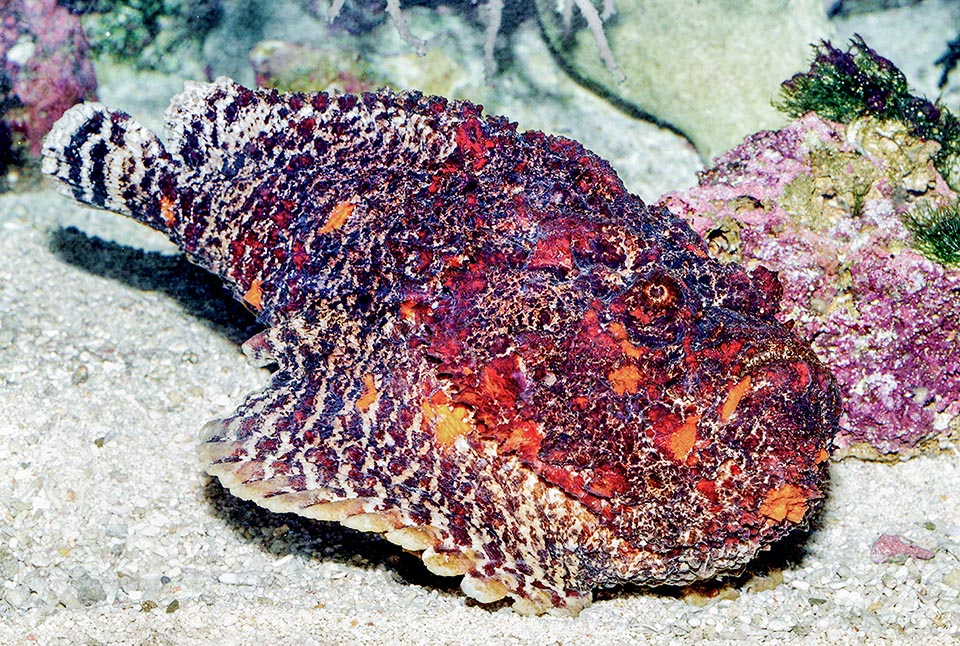
Here it’s more visible: a scaleless fish, covered by warts, the broad mouth, short snout, showy pectoral fins and the rounded tail © Giuseppe Mazza
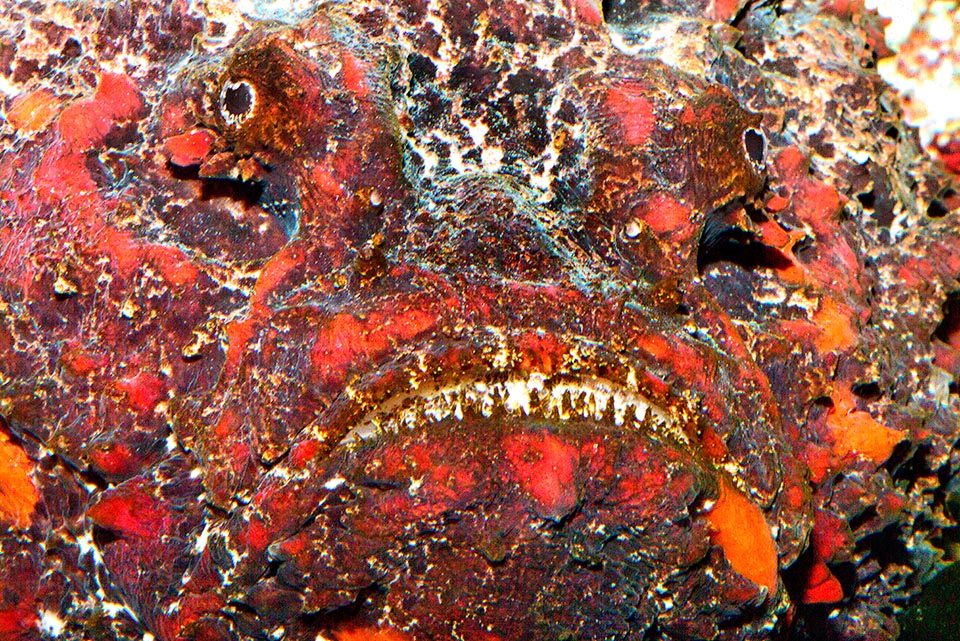
The eyes are protruding, separated by a depression, and the huge mouth however almost invisible, camouflaged as it is by the drawings © Giuseppe Mazza
Furthermore, it secretes sticky mucus which seizes fragments of corals and seaweeds thus granting a classy touch to the already perfect mimetic livery.
The head, wide with short and flattened, with almost vertical profile, carries on top two small protruding eyes, spaced by a depression, standing over the enormous horizontal mouth.
The huge pectoral fins, with 17-19 solid rays, wrap almost all the body. They are covered by small spines, but this is nothing in respect to the surprises reserved by the dorsal fin. Almost always bent, it presents, in fact, 12-14 fleshy protuberances hiding long and solid grooved spines, capable to pierce the sole of a light shoe, and 5-7 soft rays.
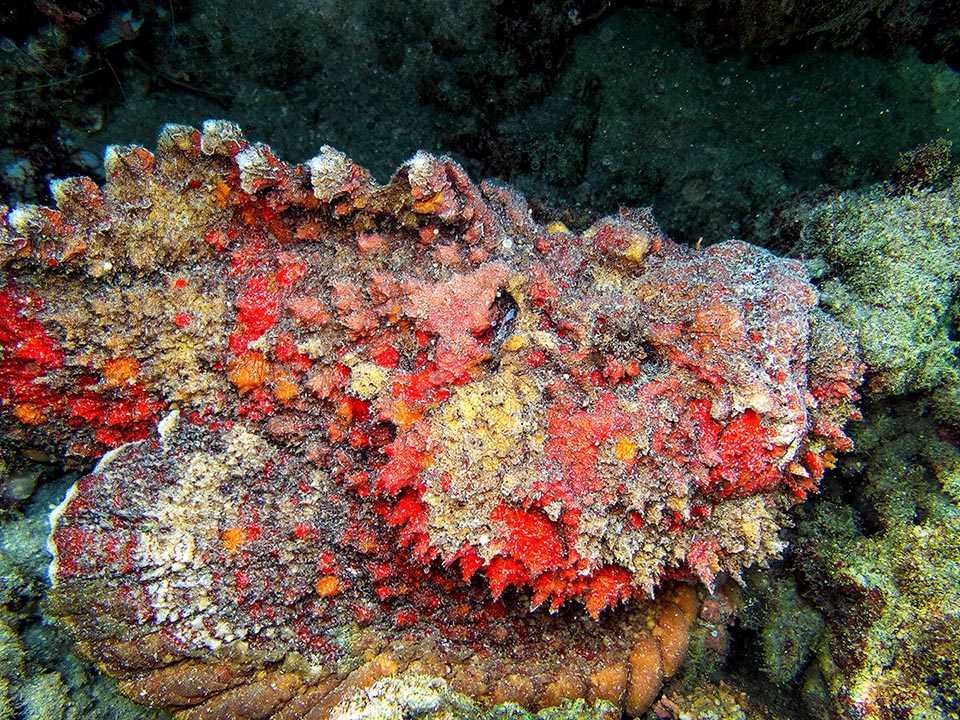
It may be 40 cm long and its powerful defense weapon stands in the solid spiny venomous rays of the dorsal fin, hidden in fleshy structures © Jean-Marie Gradot
Every spine has at the base two glands full of venom. It is the strongest poison in the world of fishes, fatal also for the man.
Its composition is much similar to that of the cobra, and, in case of puncture, it is important to intervene immediately with the specific serum. The anal fin has 3 spiny rays and 5-6 unarmed, the caudal and the ventral ones are of modest size.
Ethology-Reproductive Biology
The stonefish lives solitary feeding on fishes and crustaceans.
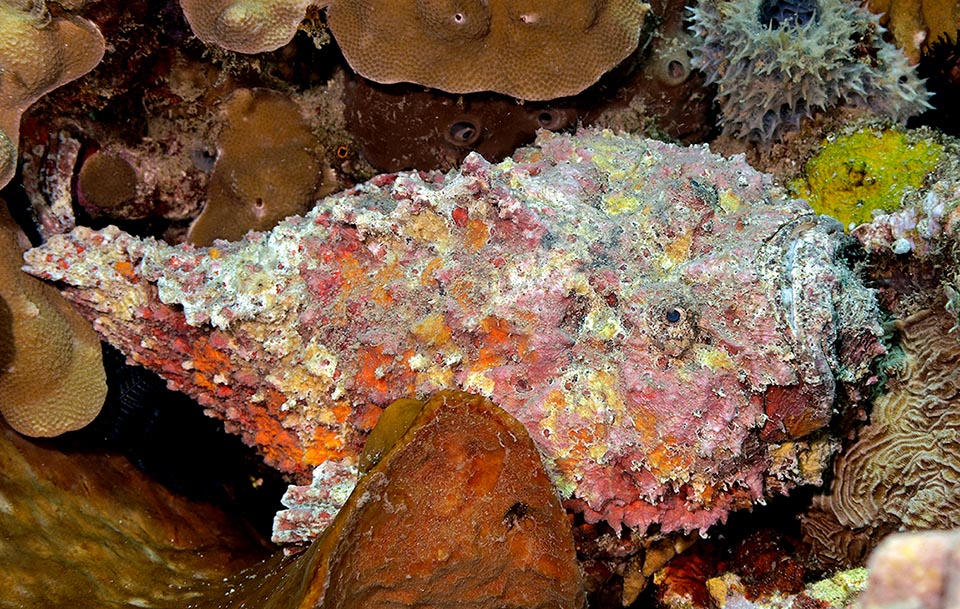
The terrible venom of Synanceia verrucosa, like that of the cobra, is deadly for humans too. The divers may at times touch it with their hands, mistaking it with a rock and if trampled on the seafront, covered by weeds or sand, the terrible spines are able to pierce even a light shoe and action must be taken immediately with the specific serum © Benoit Lallement
It relies on mimicry and hunts in ambush swallowing in about 15 thousandths of a second, the passing by unfortunates.
The males are smaller than the females. Eggs and larvae are pelagic and the fecundation is promiscuous.
Present only in the big public aquaria, it is of no interest for the aquaria market and also less the fish one, even if it is often found on sale in Hong Kong live fish market.
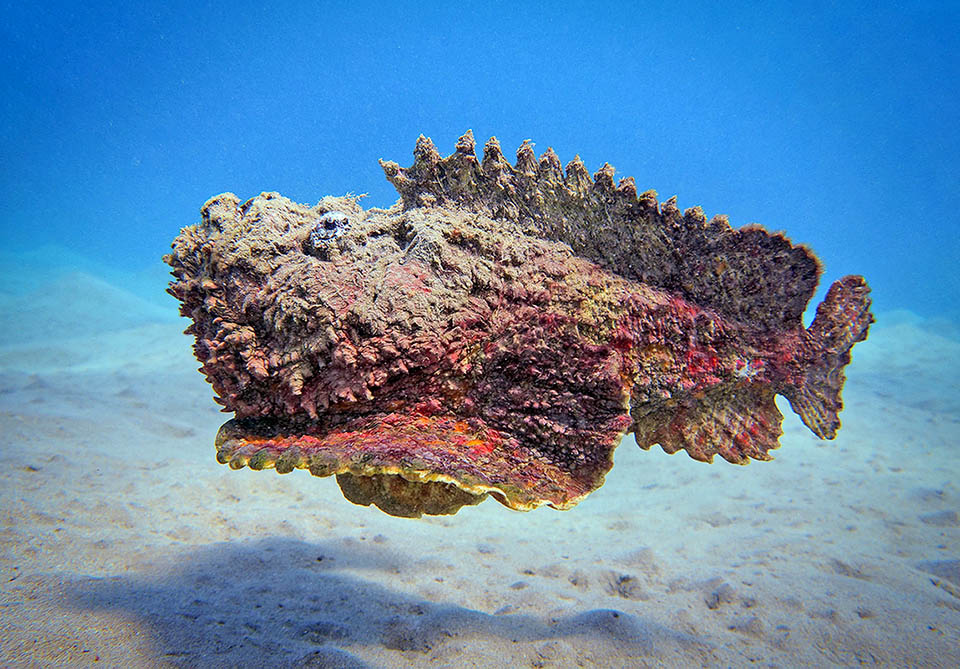
The females of Synanceia verrucosa, larger than males, entrust thousands of eggs to the currents. Fertilization is promiscuous and larvae are pelagic © Frank Käck
The fishing vulnerability index is moderate, marking 39 of a scale of 100 but the resilience is low because the doubling of the populations requires 4,5 to 14 years.
Synanceia verrucosa appears in the Red List of the endangered species as “Least Concern”.
Synonyms
Scorpaena brachion Lacepède, 1801; Synanceichthys verrucosa Bloch & Schneider, 1801; Synanceichthys verrucosus Bloch & Schneider, 1801; Synanceia brachio Cuvier, 1829.
→ For general information about FISH please click here.
→ For general information about BONY FISH please click here
→ For general information about CARTILAGINOUS FISH please click here.
→ To appreciate the BIODIVERSITY of BONY FISH please click here.
→ To appreciate the BIODIVERSITY of CARTILAGINOUS FISH please click here.
